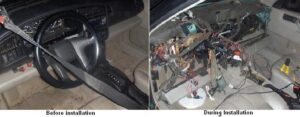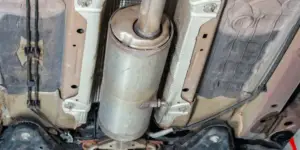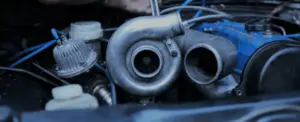There are five common reasons you’ve got wet carpets in the front of your car. Here, we’ll examine all of them along with the fixes and costs for each, but before we get into detail, the reasons are
- Clogged Windshield Cowl Drain
- Leaking Sunroof – If fitted
- Cracked Weatherproofing
- Blocked Air Conditioning (AC) Drain Hose
- Faulty Heater Core
Let’s get into the details.
1. Clogged Windshield Cowl Drain
Most modern vehicles have a plastic cover at the foot of the windshield called the cowl drain. It’s designed to trap and stop material from moving to the drain of the firewall (part separating the engine compartment from the passenger compartment.)

Sometimes pine needles or leaves pass through the cowl and travel to the firewall drain.
If this debris accumulates, it may block the firewall drain forcing water to move back up, eventually submerging the body seams and leading to wet carpets.
Solution
It is easy to access cowl drains in most modern cars.
Open up your hood and clear any materials on the cowl drains on both sides of the car, such as leaves and twigs. You may have to pop the plastic fittings at the front of your hood to access the area.
You can also use a metal coat hanger to reach debris found near or underneath the cowl drain. Here is a good video of diagnosing and fixing the problem.
Cost to fix
It is probably the cheapest and easiest fix on this list, and you can do it all by yourself at home—no need for a mechanic for this one.
If the cowl is clear, check out cause two, but only if you have a sunroof. No sunroof, then continue onto cause number three.
2. Leaking Sunroof
Your car’s sunroof has a drainage system to prevent excess rainwater from seeping into your cabin. There are two reasons why they leak.
If the sunroof seal is worn out or has lost its integrity – as they often do as the rubber ages – it’ll no longer stop water from getting into your car.
or
The drain is blocked and not allowing water to escape.
In either case, if not rectified – The leaking water may flow down to your carpets through gravity and puddle up over time.
Solution
Drive your car to a level parking ground and pour a jug of water on top of the sunroof.
Check below your car to see that the water comes out to the ground fairly quickly. If yes, the drain isn’t blocked. That doesn’t mean your sunroof seals are okay.
From inside the cabin, check for any drips around the sunroof. No drips? The sunroof is okay and not causing the wet carpets.
Cost to fix
Unblocking the drain is an easy fix, but if that is clear, a new sunroof assembly seal unit costs $100 to $250, depending on the make and model of the car, and an additional $250 to $370 at an auto repair shop in labor costs.
3 Damaged Weatherproofing
Your car has black rubber seals on the edge of the windshield, doors, and windows that protect the cabin from the weather.
These rubber seals get worn out and damaged after some time, causing leaks.
Solution
Finding the faulty point on the seal is the tricky part. Using a water hose helps pinpoint it. Remove the worn-out seal, then wipe the replacement seal and weather-stripping channel using a gentle cleanser and wait for it to dry.
Apply weatherproofing adhesive thinly on the channel, and carefully install the replacement seal.
Once everything is well aligned, push the proofing firmly into place.
It’s worth checking the condition of all the seals. If one area has worn, other areas are likely close to failing.
Swapping over these areas would be easier than waiting until they start letting in water.
Cost to fix
It will cost you around $30 to $180 to replace if you do it yourself. It’s quite an easy job, as shown in the video
4. Blocked Air Conditioning (AC) Drain, Hose
The AC on your car keeps you warm or cool by removing heat from the air. Or adding heat to it.
The AC evaporator absorbs and eliminates moisture and carries it away to the ground through a hose.
The AC generates condensation just like your refrigerator at home. When the drain hose is clogged, condensation can no longer drain out properly.
After a while, it overflows and finds its way back to the cabin and the front carpets, making them damp.
You might hear a sloshing water sound at the back of your dashboard when your AC is running, especially when you turn. This sound and the damp floor are indicators of a clogged drain hose.
Solution
You should first identify the location of your AC drain by checking the manual or searching your car’s model on google. It’s usually black and pokes through the firewall a couple of inches into the engine area.
Once you’ve located it, press the end of the drain hose. It usually clears up the blockage.
If this fails, you can try using a blunt object, coat hangar, or air compressor to unblock it.
If you’re sure it’s clear and no water has leaked out of it, then it’s time to move on to the final and most expensive reason.
Cost to fix
Unclogging the drain hose is simple as long as you know where it is. In most cases, it will only cost you your time and effort since you will need to squeeze out all the water from the hose, but in other cases, you will pay around $75 to $250 to get it fixed.
5. Faulty Heater Core
So you’ve investigated the other three or four potential causes and still haven’t found the culprit.
The final reason is the most expensive, I’m afraid.
The heater core is part of your car’s Heating, cooling, and air quality system (HVAC).
When the heater core starts leaking, coolant collects on the passenger floor. Do you notice a fruity smell inside your cabin? That’s a clear indicator of the heater core leaking.
Often when it leaks, it’s because of corrosion and rust. If water, rather than the coolant, has been used to top up the reservoir level, it’s more likely.
It is essential to get your leak fixed as soon as possible because the more the coolant escapes from the cooling system, the more likely your engine will overheat.
Solution
Wait till your car is cold before adding a radiator stop leak in the radiator. Let the engine run for a couple of minutes to distribute the sealant throughout the system. This may work if the heater core only has a small hole.
For heater cores with larger corroded areas, it may not work.
Changing your coolant every two years also prevents corrosion of the heater components.
Cost to Fix
Depending on the amount needed, you can get a radiator stop leak at your local automotive store for around $5 to $35. If that fails, a heater core replacement may cost you around $800 on average, including the parts and labor costs.
In Conclusion
Wet front passenger carpets indicate a clogged windshield cowl drain, a leaking sunroof – If fitted,
cracked weatherproofing, blocked air conditioning drain hoses, or a faulty heater core.













